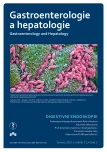Drug-induced sleep endoscopy – targeted endoscopic diagnosis in patients with obstructive sleep apnea
Authors:
J. Hybášková 1,2; O. Jor 3; V. Novák 4; P. Matoušek 1,2; Pavel Komínek 1,2
Authors‘ workplace:
Klinika otorinolaryngologie a chirurgie hlavy a krku LF OU a FN Ostrava
1; Katedra kraniofaciálních oborů, LF OU, Ostrava
2; Klinika anesteziologie, resuscitace a intenzivní medicíny, LF OU a FN Ostrava
3; Centrum pro poruchy spánku a bdění – spánková laboratoř, Klinika dětské neurologie LF OU a FN Ostrava
4
Published in:
Gastroent Hepatol 2017; 71(3): 193-198
Category:
Digestive Endoscopy: Original Article
doi:
https://doi.org/10.14735/amgh2017193
Overview
Aims:
Obstructive sleep apnea (OSA) is characterized by repetitive pauses in breathing during sleep, despite the effort to breathe, and is caused by obstruction of the upper airway. Determining the location of the upper airway obstruction is a diagnostic and therapeutic challenge.
Methods:
Seventy-one patients with OSA (9 women and 62 men) underwent awake examination with nasendoscopy and drug-induced sleep endoscopy (DISE). Collapse of the upper airway during wakefulness and DISE was compared. Indications for surgery according to otorhinolaryngology examination before and after DISE were also compared.
Results:
During wakefulness and DISE, palatal collapse was different in 30.1% (22/71), oropharyngeal collapse in 66.2% (47/71), tongue base collapse in 39.4% (28/71), and laryngeal collapse in 32.4% (23/71) patients. After DISE, the surgical plan was changed in 66.2% (47) of the patients.
Conclusions:
In patients with OSA, DISE helps to identify the site of upper airway obstruction more accurately. The larynx plays an important role in OSA. Furthermore, DISE changes surgical decision-making compared with awake evaluation methods.
Key words:
drug-induced sleep endoscopy – obstructive sleep apnea – flexible endoscopy – upper airway – epiglottis
The authors declare they have no potential conflicts of interest concerning drugs, products, or services used in the study.
The Editorial Board declares that the manuscript met the ICMJE „uniform requirements“ for biomedical papers.
Submitted:
15. 1. 2017
Accepted:
22. 2. 2017
Sources
1. Friedman M. Sleep apnea and snoring, surgical and non-surgical therapy. China: Saunders Elsevier 2009.
2. Campanini A, Canzi P, De Vito A et al. Awake versus sleep endoscopy: personal experience in 250 OSAHS patiens. Acta Otorhinolaryngol Ital 2010; 30 (2): 73–77.
3. Fernández-Julián E, García-Pérez MÁ, García-Callejo J et al. Surgical planning after sleep versus awake techniques in patient with obstructive sleep apnea. Laryngoscope 2014; 124 (8): 1970–1974. doi: 10.1002/lary.24577.
4. De Vito A, Llatas MC, Vanni A et al. European position paper on drug-induced sedation endoscopy (DISE). Sleep Breath 2014; 18 (3): 453–465. doi: 10.1007/s11325-014-0989-6.
5. Hybášková J, Babiarová V, Jor O et al. Flexibilní endoskopie horních cest dýchacích v léky navozeném spánku. Otorinolaryng a Foniat 2016; 65 (1): 30–34.
6. Cavaliere M, Russo F, Iemma M. Awake versus drug-induced sleep endoscopy: evaluation od airway obstruction in obstructive sleep apnea/hypoponoea syndrome. Laryngoscope 2013; 123 (9): 2315–2318.
7. Aktas O, Erdur O, Cirik AA et al. The role of drug-induced sleep endoscopy in surgical planning for obstructive sleep apnea syndrome. Eur Arch Otorhinolaryngol 2015; 272 (8): 2039–2043. doi: 10.1007/s00405-014-3162-8.
8. De Corso E, Fiorita A, Rizzotto G et al. The role of drug-induced sleep endoscopy in the diagnosis and management of obstructive sleep apnea syndrome: our personal experience. Acta Otorhinolaryngol Ital 2013; 33 (6): 405–413.
9. Kezirian EJ, Hohenhorst W, de Vries N. Drug-induced sleep endoscopy: the VOTE classification. Eur Arch Otorhinolaryngol 2011; 268 (8): 1233–1236. doi: 10.1007/s00405-011-1633-8.
10. Phang, KP, Rotenberg BW, Woodson BT. Advanced surgical techniques in snoring and obstructive sleep apnea. CA: Plural Pub 2013.
11. Salamanca F, Constantini F, Bianchi A et al. Identification of obstructive sites and pattwens in obstructive sleep apnoea synrome by sleep endoscopy in 614 patients. Acta Otorhinolaryngol Ital 2013; 33 (4): 261–266.
12. Vroegop VA, Vanderveken OM, Boudewyns N et al. Drug-induced sleep endoscopy in sleep-disordered breathing: report on 1249 cases. Laryngoscope 2014; 124 (3): 797–802. doi: 10.1002/lary.24479.
13. Torre C, Camacho M, Liu SY et al. Epiglottis collapse in adult obstructive sleep apnea: a systematic review. Laryngoscope 2016; 126 (2): 515–523. doi: 10.1002/lary.25589.
14. Nevšímalová S, Šonka K et al. Poruchy spánku a bdění. Brno: Maxdorf Jessenius 1997.
15. Pileate K, Medts J, Delsupehe KG. Drug-induced sleep endoscopy changes snoring management plan very significantly compared to standard clinical evaluation. Eur Arch Otorhinolaryngol 2014; 271 (5): 1311–1319. doi: 10.1007/s00405-013-2795-3.
Labels
Paediatric gastroenterology Gastroenterology and hepatology SurgeryArticle was published in
Gastroenterology and Hepatology

2017 Issue 3
Most read in this issue
- Rifaximin
- Guidelines of the IBD working group of the Slovak Gastroenterology Society on the management of ulcerative colitis
- Colonic decompression in daily practice
- Difficult diagnostics and serious biliary complications of liver echinococcosis
